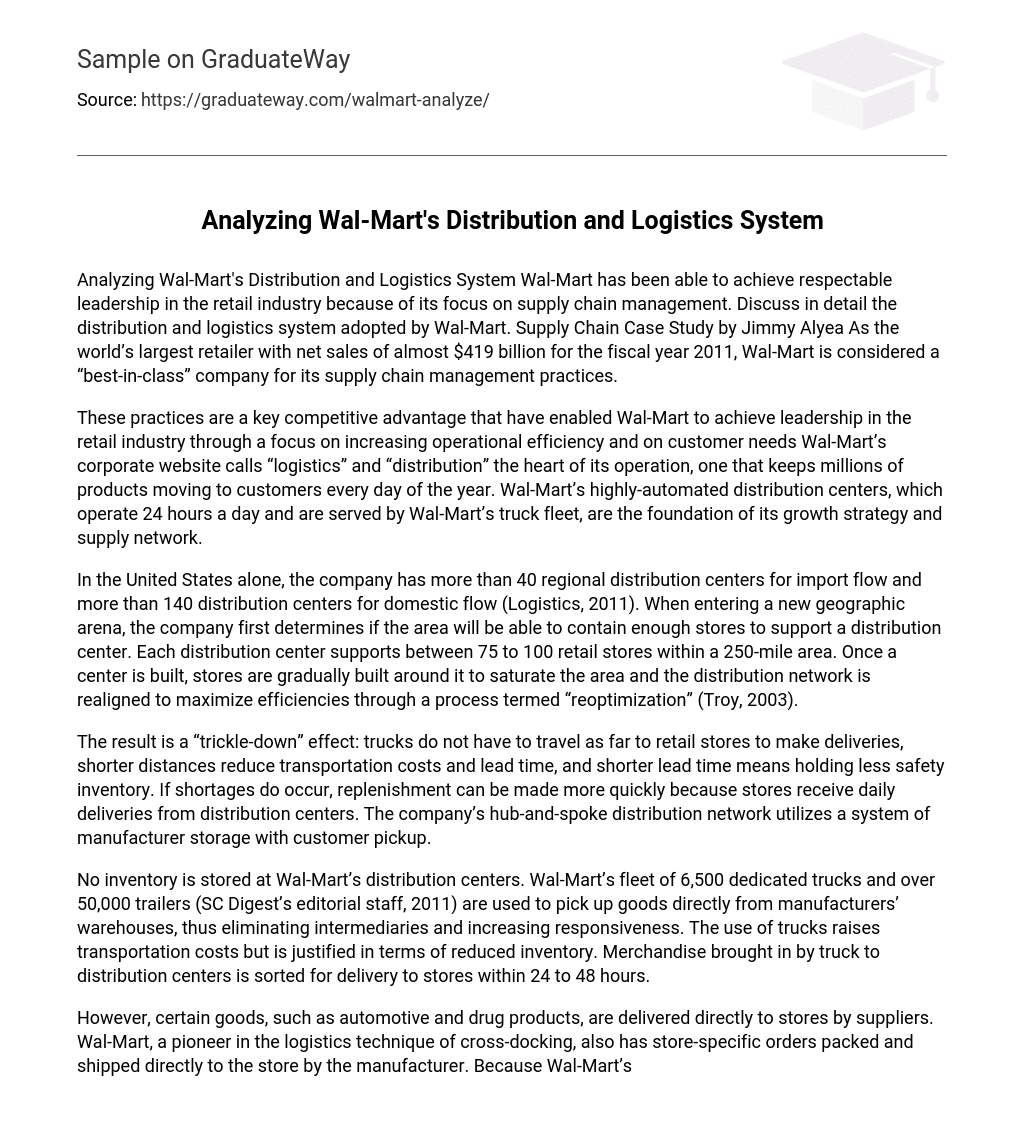Analyzing Wal-Mart’s Distribution and Logistics System Wal-Mart has been able to achieve respectable leadership in the retail industry because of its focus on supply chain management. Discuss in detail the distribution and logistics system adopted by Wal-Mart. Supply Chain Case Study by Jimmy Alyea As the world’s largest retailer with net sales of almost $419 billion for the fiscal year 2011, Wal-Mart is considered a “best-in-class” company for its supply chain management practices.
These practices are a key competitive advantage that have enabled Wal-Mart to achieve leadership in the retail industry through a focus on increasing operational efficiency and on customer needs Wal-Mart’s corporate website calls “logistics” and “distribution” the heart of its operation, one that keeps millions of products moving to customers every day of the year. Wal-Mart’s highly-automated distribution centers, which operate 24 hours a day and are served by Wal-Mart’s truck fleet, are the foundation of its growth strategy and supply network.
In the United States alone, the company has more than 40 regional distribution centers for import flow and more than 140 distribution centers for domestic flow (Logistics, 2011). When entering a new geographic arena, the company first determines if the area will be able to contain enough stores to support a distribution center. Each distribution center supports between 75 to 100 retail stores within a 250-mile area. Once a center is built, stores are gradually built around it to saturate the area and the distribution network is realigned to maximize efficiencies through a process termed “reoptimization” (Troy, 2003).
The result is a “trickle-down” effect: trucks do not have to travel as far to retail stores to make deliveries, shorter distances reduce transportation costs and lead time, and shorter lead time means holding less safety inventory. If shortages do occur, replenishment can be made more quickly because stores receive daily deliveries from distribution centers. The company’s hub-and-spoke distribution network utilizes a system of manufacturer storage with customer pickup.
No inventory is stored at Wal-Mart’s distribution centers. Wal-Mart’s fleet of 6,500 dedicated trucks and over 50,000 trailers (SC Digest’s editorial staff, 2011) are used to pick up goods directly from manufacturers’ warehouses, thus eliminating intermediaries and increasing responsiveness. The use of trucks raises transportation costs but is justified in terms of reduced inventory. Merchandise brought in by truck to distribution centers is sorted for delivery to stores within 24 to 48 hours.
However, certain goods, such as automotive and drug products, are delivered directly to stores by suppliers. Wal-Mart, a pioneer in the logistics technique of cross-docking, also has store-specific orders packed and shipped directly to the store by the manufacturer. Because Wal-Mart’s fast, responsive transportation operations are such a major part of the company’s successful logistics system, great care is taken in the hiring, training, supervising, and assigning of drivers’ schedules and job responsibilities.
From the onset of his retailing career, Wal-Mart founder Sam Walton recognized the importance of hiring experienced people and of building loyalty not only in his customers but also in his employees. The company hires only experienced drivers who have driven more than 300,000 accident-free miles and whom it believes will be committed to customer service. Its retail stores are considered important “customers” of the distribution centers. As stated in the “Private Fleet Driver Handbook” that each driver is given a copy of, drivers are expected to be “polite” and “kind” when dealing with store personnel and others.
In addition to containing a driver’s code of conduct, the Private Fleet Driver Handbook gives instructions and rules for following pre-planned travel routes and schedules, the responsible unloading of a truck trailer at a retail store, and the safe-guarding of Wal-Mart’s property. For example, although drivers deliver loaded trailers in the afternoon and evening hours, a trailer can be brought to the store’s docks only at its scheduled unloading time.
Because unloading is done at two-hour intervals during the night, a driver is expected to spend the night, returning to the distribution center at a pre-scheduled time with an empty trailer. Coordinators closely monitor the detailed records of each driver’s activities for adherence to rules. Violations are dealt with according to handbook procedures, which include employee education to prevent future occurrences of incorrect actions. By effectively managing every aspect of its transportation operations and treating its drivers fairly, Wal-Mart gets results that are unrivaled in the logistics arena.
This philosophy parallels the successful coaching style of New York Giant’s football coach Tom Coughlin who believes that rules are more than just discipline. Rules are a key to consistency, which leads to preparedness, which then leads to proper execution (Pennington, 2012). Copyright 2012 James L. Alyea. All Rights Reserved. About Jimmy Alyea: Jimmy Alyea lives in Houston, Texas, and holds two Bachelor of Business Administration degrees (Supply Chain Management and Marketing) and a Master of Business Administration degree. Follow Jimmy Alyea (James L. Alyea) on LinkedIn, Twitter, or Blog.
References
Chandran, P. M. (2003). Wal-Mart’s supply chain management practices. ICFAI Center for Management Research. Retrieved from www. icmrndia. org Chopra, S. , & Meindl, P. (2010). Supply chain management: strategy, planning, and operation. 4th ed. Prentice Hall: New York. Logistics. (2011). Walmartstores. com. Retrieved from http://walmartstores. com/AboutUs/7794. aspx. Pennington, B. (2012, January 22). Tom Coughlin goes by the book and wins. New York Times.
Retrieved from http://www. nytimes. com/2012/01/22/sports/football/tom-coughlin-goes-by-the-book-and-wins. html? pagewanted=all SC Digest’s editorial staff. (2011, October 12). Wal-Mart tells CSCMP audience it is more flexible on inbound transportation program. Supply Chain Digest. Retrieved from http:www. scdigest. com/ONTARGET/11-10-12-1_Walmart_Inbou… Troy, M. (2003). Logistics still cornerstone of competitive advantage. Retailing Today. Retrieved from http://search. proquest. com. ezproxy. udh. edu/docprintview/22851744…





